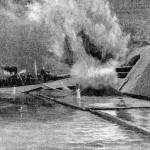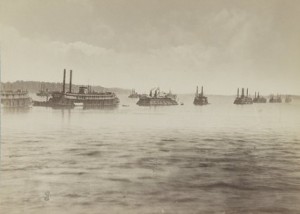 “Pook Turtles, Armorclads and the Civil War on the Rivers”, my fourth piece for the New York Times “Disunion” feature, deals with the ironclads on the western rivers. Little know, these warships truly helped shorten the war Continue reading
“Pook Turtles, Armorclads and the Civil War on the Rivers”, my fourth piece for the New York Times “Disunion” feature, deals with the ironclads on the western rivers. Little know, these warships truly helped shorten the war Continue reading
Category Archives: Ironclads and Gunboats
New York Times “Disunion”: Raiding the Keokuk
 My third piece for the New York Times “Disunion” series is now online. “Raiding the Keokuk” is about a daring salvage operation of an enemy warship in contested waters. The warship, USS Keokuk, is one of those oddities of technology that really should never have been built. As necessity during wartime can result in brilliant success — i.e. USS Monitor — it can also generate spectacular failures.
My third piece for the New York Times “Disunion” series is now online. “Raiding the Keokuk” is about a daring salvage operation of an enemy warship in contested waters. The warship, USS Keokuk, is one of those oddities of technology that really should never have been built. As necessity during wartime can result in brilliant success — i.e. USS Monitor — it can also generate spectacular failures.
I’m really happy with this piece as I was able to get much closer to individuals and a single ship. USS Keokuk, while not a successful design, was a unique looking vessel, and I have a model of her in-progress that I look forward to completing.
Direct link to article HERE.
USS Chickasaw Part 9: Stern-O-Plasty
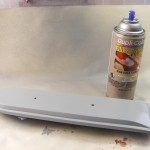
I’d planned on the joining of the upper and lower hulls on Chickasaw to be an ordeal, but it wasn’t as bad in some respects as I’d expected, but was worse in other respects. While Chickasaw doesn’t have the full “raft over a lower hull” arrangement of the original Monitor or her follow-on Passaic class ironclads, it does exist. While building the lower hull, I exerted too Continue reading
New York Times “Disunion”: Rise of the Infernal Machines
My second piece for the Times’ “Disunion” web series has been published. “Rise of the Infernal Machines” gives an overview of the torpedoes of the day, what we now mostly know as mines. Crude, unstable, and mostly non-functional, they provided the Confederacy with a new weapon with which to strike back at the superior Union navy. Despite their endless problems, they succeeded in sinking more Union warships than all other means combined (probably speaking more to the ineffectiveness of Confederate warships and fortifications than to effectiveness of the torpedoes). The article can be access HERE.
New York Times “Disunion” Piece Published
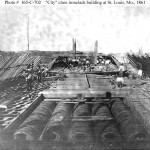 Very happy to announce that the New York Times has published my first piece for their website. Ironclad Fever is about the armored warship building frenzy in both North and South after the Monitor and Virginia (Merrimack) battle in 1862.
Very happy to announce that the New York Times has published my first piece for their website. Ironclad Fever is about the armored warship building frenzy in both North and South after the Monitor and Virginia (Merrimack) battle in 1862.
I’m extremely pleased to be able to put all of the historical research I’ve done while building models and writing stories into this format.
150 Years Ago Today: USS Cairo, Preserved by Gunpowder
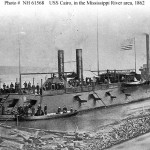 “…I heard an explosion from the Cairo, and on looking up (from a small boat on the river) I saw her anchor thrown up several feet in the air.” – Ensign Walter E.H. Fentress
“…I heard an explosion from the Cairo, and on looking up (from a small boat on the river) I saw her anchor thrown up several feet in the air.” – Ensign Walter E.H. Fentress
“…just as we were training on the battery (gun emplacement or torpedo), we were struck by a torpedo, which exploded under our starboard bow, a few feet from the center and some 35 or 40 feet from the bow proper just under our provision store room, which crushed in the bottom of the boat so that the water rushed in like the roar of Niagara. In five minutes the Hold was full of water and the forward part of the gunboat was flooded… One of our heaviest bow guns had been dismounted by the force of the explosion, injuring three men. ” -George Yost.
On December 12th, 1862, the American Civil War saw yet another military first: USS Cairo became the first warship sunk by an underwater mine, or torpedo as they were known at the time. The Union Navy had known of Continue reading
150 Years Ago Today: USS Monitor vs. CSS Virginia
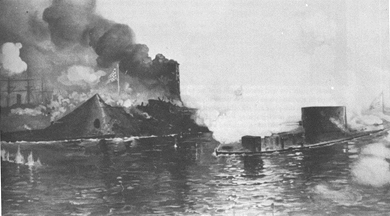 In a state-of-the-art museum and conservation lab in Newport News, Virginia, sit large tanks of fresh water that hold large rusting chunks of iron that are over 150 years old. 150 years isn’t a long time for some museum artifacts; in Manhattan one can visit the Metropolitan Museum and see Buddhist statues over 500 years old, then walk several yards down the hall and see mummies thousands of years old. But the significance of the rusted iron from USS Monitor that rests in The Mariner’s Museum in Virginia isn’t in its age; it’s in the revolution that it brought.
In a state-of-the-art museum and conservation lab in Newport News, Virginia, sit large tanks of fresh water that hold large rusting chunks of iron that are over 150 years old. 150 years isn’t a long time for some museum artifacts; in Manhattan one can visit the Metropolitan Museum and see Buddhist statues over 500 years old, then walk several yards down the hall and see mummies thousands of years old. But the significance of the rusted iron from USS Monitor that rests in The Mariner’s Museum in Virginia isn’t in its age; it’s in the revolution that it brought.
The battle between USS Monitor and CSS Virginia 150 years ago today is one of the few naval battles, Continue reading
USS Weehawken: Scribing
After some time away from the work bench I have returned to the USS Weehawken. After weeks of looking at it, sitting there, mocking me as I mulled over ways to approach the armor plating on the deck, I finally decided to just dive in.
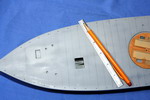 I worked off of what few photos could be found on the internet of the actual monitor, photos of other monitor kits, and photos of models that others have built. I decided the brick-like layout that is most commonly depicted is probably the best bet, as there is little evidence against it. I started by drawing laying a pencil line down the center of the deck. Fortunately that was easy, as every line on the deck is either parallel or perpendicular to this line, so it had to be straight. I then marked off the perpendicular lines, continually checking them with dividers and a square. I decided the distance between them again by photo guesstimates, and by the fact that I have a ruler that is darn close to being as wide as measurements that I came up with.
I worked off of what few photos could be found on the internet of the actual monitor, photos of other monitor kits, and photos of models that others have built. I decided the brick-like layout that is most commonly depicted is probably the best bet, as there is little evidence against it. I started by drawing laying a pencil line down the center of the deck. Fortunately that was easy, as every line on the deck is either parallel or perpendicular to this line, so it had to be straight. I then marked off the perpendicular lines, continually checking them with dividers and a square. I decided the distance between them again by photo guesstimates, and by the fact that I have a ruler that is darn close to being as wide as measurements that I came up with.
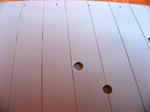 Next came out the scribing tool. I’ve never scribed anything on this scale before and it was daunting. I used a special tool that Squadron Hobbies produces (it looks like a particularly nasty dental scraper). It removes a fine ribbon of material on each pass, and after three passes on each line with the smaller head, it was done. The resin on this kit has more tiny airbubbles than I would like to see, and at points the tool did dig into pockets of them and cause irregular edges, but for the final “used” look I want for this model it wasn’t a deal-breaker.
Next came out the scribing tool. I’ve never scribed anything on this scale before and it was daunting. I used a special tool that Squadron Hobbies produces (it looks like a particularly nasty dental scraper). It removes a fine ribbon of material on each pass, and after three passes on each line with the smaller head, it was done. The resin on this kit has more tiny airbubbles than I would like to see, and at points the tool did dig into pockets of them and cause irregular edges, but for the final “used” look I want for this model it wasn’t a deal-breaker.
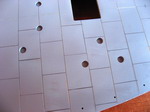 After scribing those lines, out came the pencil and the straightedge and I began drawing in the alternating lines parallel to centerline, that run fore and aft. I continually checked my work with dividers to make sure I kept every resulting rectangle the same size. I’m almost positive this symmetry was not present on the real ships, but with nothing else to go on to contradict the pattern, I kept it as it adds a nice visual effect.
After scribing those lines, out came the pencil and the straightedge and I began drawing in the alternating lines parallel to centerline, that run fore and aft. I continually checked my work with dividers to make sure I kept every resulting rectangle the same size. I’m almost positive this symmetry was not present on the real ships, but with nothing else to go on to contradict the pattern, I kept it as it adds a nice visual effect.
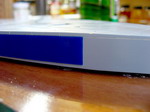 I went with the assumption that the armor plates terminated at the very edge of the hull. They did this on the original Monitor, so why not? This meant I needed a line the thickness of the plates on the side of the hull. The blue tape is Dynamo label tape, from those old plastic label makers. It’s thick enough to provide a solid edge for the scribing tool to run along. I measured off the thickness of the plates to something that looks good and applied the tape. I don’t like to leave it on the model too long as it has a tendency to pull the primer from some of those air bubble areas on the hull, so I lay it down, scribe the line, and remove it.
I went with the assumption that the armor plates terminated at the very edge of the hull. They did this on the original Monitor, so why not? This meant I needed a line the thickness of the plates on the side of the hull. The blue tape is Dynamo label tape, from those old plastic label makers. It’s thick enough to provide a solid edge for the scribing tool to run along. I measured off the thickness of the plates to something that looks good and applied the tape. I don’t like to leave it on the model too long as it has a tendency to pull the primer from some of those air bubble areas on the hull, so I lay it down, scribe the line, and remove it.
Quite a bit of progress for only a weeks work, off and on. Now I have to figure out how to replicate the flush-faced rivets that are needed on the sides of the hull.
Back to some resin
 With my final paper of the semester turned in, I’ve decided to clean up some stories to send out (sent out two this very day) and work on some models. I’m still at it with the USS Weehawken. It seems like I’m just not making any progress. This part of a build always seems like that. You fill, prime, sand, repeat. And repeat. And repeat. One interesting thing that I found was the visual effect in the first photo. The last time I primed I got lazy and just hit the areas I had sanded. The contrast of old and new primer gives a great textured effect. It’s something I’ll be repeating — in a more controlled manner — when I do the final painting, so it’s great to see a preview of what can be accomplished. Now it’s time for me to scribe all of the armor plating lines onto the deck. That will be quite an undertaking, and one I’ve been putting off.
With my final paper of the semester turned in, I’ve decided to clean up some stories to send out (sent out two this very day) and work on some models. I’m still at it with the USS Weehawken. It seems like I’m just not making any progress. This part of a build always seems like that. You fill, prime, sand, repeat. And repeat. And repeat. One interesting thing that I found was the visual effect in the first photo. The last time I primed I got lazy and just hit the areas I had sanded. The contrast of old and new primer gives a great textured effect. It’s something I’ll be repeating — in a more controlled manner — when I do the final painting, so it’s great to see a preview of what can be accomplished. Now it’s time for me to scribe all of the armor plating lines onto the deck. That will be quite an undertaking, and one I’ve been putting off.
The second photo is of an interior space. I’m opening up the hatches on Weehawken, so I go to the plans and see what’s under these hatches. The after-most lists it as “engineering” and nothing more. Going off of a paper model of the original USS Monitor, I knocked out this quick bit of plastic gibberish. Once it’s painted, weathered, and viewed through the small 1″ X 1″ opening in the deck, it’ll look just fine.
 I’m replacing certain parts of the Weehawken kit. This shot is a before and after (well, an in-progress). The turret roof is supplied in a circle of perforated resin. I’m putting a lot of detail in this turret, so I’ll be replacing it with a clear piece of plastic. I’ve used double-sided tape to attach the plastic replacement to the resin original, and now I’m drilling through the resin perforations, using it to transfer the pattern over to the clear part. Tedious.
I’m replacing certain parts of the Weehawken kit. This shot is a before and after (well, an in-progress). The turret roof is supplied in a circle of perforated resin. I’m putting a lot of detail in this turret, so I’ll be replacing it with a clear piece of plastic. I’ve used double-sided tape to attach the plastic replacement to the resin original, and now I’m drilling through the resin perforations, using it to transfer the pattern over to the clear part. Tedious.
And finally, this green guy. It’s a white-metal Dungeons and Dragons gaming figure, about 1.5″ tall, and still very much in-progress. I found him while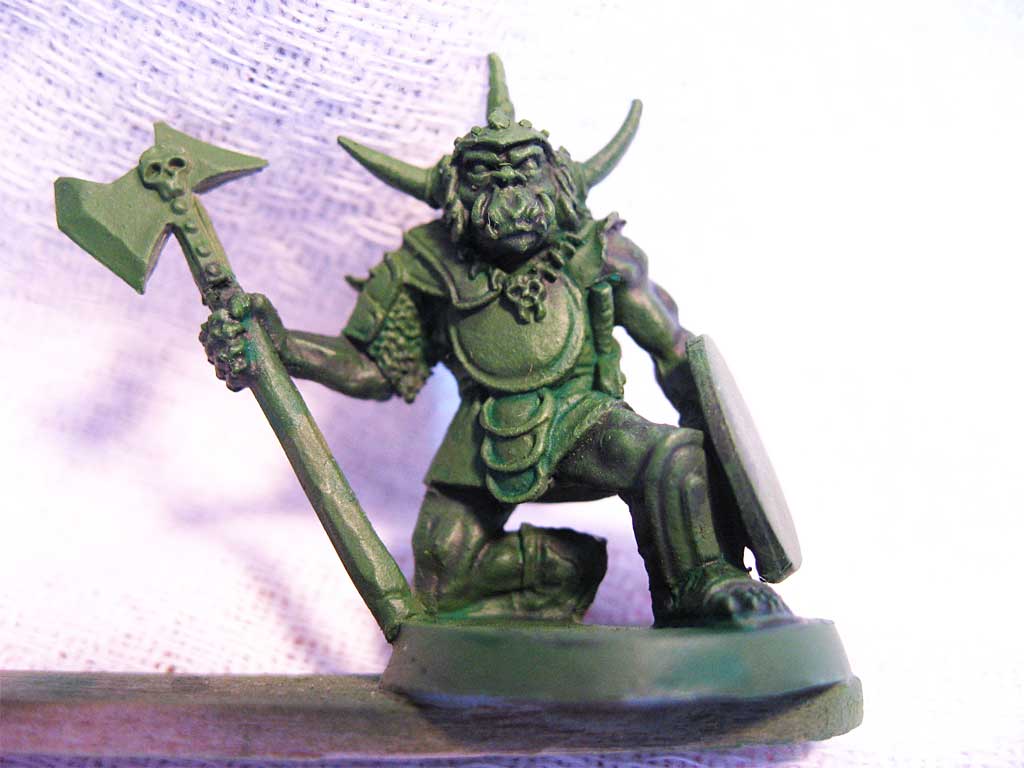 cleaning up a few weeks back and figured he’s a good piece to practice with the Vallejo paints I’ve recently started using (they rock), and it’s a piece I can finish in a relative short period of time. Sometimes it’s good to just finish something, even if it isn’t that big of an undertaking — I guess that’s why I write short stories as well.
cleaning up a few weeks back and figured he’s a good piece to practice with the Vallejo paints I’ve recently started using (they rock), and it’s a piece I can finish in a relative short period of time. Sometimes it’s good to just finish something, even if it isn’t that big of an undertaking — I guess that’s why I write short stories as well.
Picking a Subject: USS Weehawken

So, I continually try to figure out why I write what I write and why I build the models that I build. And recently, more often than not, I’m finding out that whatever the subject, my interests in the two mediums are often closely related.
My current modeling project is a 1/96th scale resin kit of the USS Weehawken. She was an American Civil War monitor. I’ll get more into her history later as I talk about building the kit. But for now all you need to know is she was one of the most powerful warships of the period and she sank. She did not sink to enemy fire, but to weather and waves many would not consider rough. During an ammunition onload someone failed to properly distribute the heavy iron shot, leaving her out of trim and down by the head. On 6 December 1863 she sank in “choppy” water. She took a few waves over the bow and went down within minutes. Between 24 and 30 men of her 70+ crew drowned in water so shallow that nearly one-quarter of her stack was reportedly sticking above the waves after she settled on bottom.
I’ve always been intrigued by this story. I guess it’s a fairly common one of technology being overcome by nature, but it pulled me in so much that I started writing my own fictionalized version of the sinking. Who was responsible for not stowing the ammunition properly? Even with that, was there someone asleep at the pumps that could have stopped the disaster? (Actually they couldn’t have. An engineering “feature” of these ships had all of the pumps aft in the engine room; useless in Weehawken’s bow-down attitude.) I began conjuring images of a man tormented by the heat of these steel ships in Southern waters, the thud of enemy cannon balls striking the hull, the thick smoky air. And, what the hell, maybe he thought there were mermaids just through the thin hull beckoning him out into the cool waters. I wrote a few paragraphs.
The words lead to a desire to build a kit of the ship. I got luck, someone actually made a kit. That’s always a plus. I have little room to scratch-build at this time. And I found it cheap on eBay! Another plus. I could have built this model as any of the other ships of the
The building progressed, but then I lost interest in the story. It wasn’t going anywhere after those initial few pages and I had recently written two war themed pieces. Another one seemed a little much at the time. But as I found my interest in the words on the wane, my interest in the model was growing.
I’m currently more than half-way through the build, and now that I can lay my hands upon an approximation of her hull, see where the water came in, and imagine the death rattle of steel and equipment subsiding into gurgling seawater. The story starts to come back to me. No one has ever accused me of being drawn to cheerful stories, and the model, a solid material focus, makes the images I conjure in my mind more real. Solid.
One day I’ll come back to my story of the
